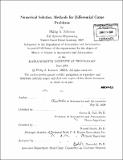Numerical solution methods for differential game problems
Author(s)
Johnson, Philip A. (Philip Arthur)
DownloadFull printable version (12.97Mb)
Other Contributors
Massachusetts Institute of Technology. Dept. of Aeronautics and Astronautics.
Advisor
Steven R. Hall and Russell Smith.
Terms of use
Metadata
Show full item recordAbstract
Differential game theory provides a potential means for the parametric analysis of combat engagement scenarios. To determine its viability for this type of analysis, three frameworks for solving differential game problems are evaluated. Each method solves zero-sum, pursuit-evasion games in which two players have opposing goals. A solution to the saddle-point equilibrium problem is sought in which one player minimizes the value of the game while the other player maximizes it. The boundary value method is an indirect method that makes use of the analytical necessary conditions of optimality and is solved using a conventional optimal control framework. This method provides a high accuracy solution but has a limited convergence space that requires a good initial guess for both the state and less intuitive costate. The decomposition method in which optimal trajectories for each player are iteratively calculated is a direct method that bypasses the need for costate information. Because a linearized cost gradient is used to update the evader's strategy the initial conditions can heavily influence the convergence of the problem. The new method of neural networks involves the use of neural networks to govern the control policy for each player. An optimization tool adjusts the weights and biases of the network to form the control policy that results in the best final value of the game. An automatic differentiation engine provides gradient information for the sensitivity of each weight to the final cost. (cont.) The final weights define the control policy's response to a range of initial conditions dependent upon the breadth of the state-space used to train each neural network. The neural nets are initialized with a normal distribution of weights so that no information regarding the state, costate, or switching structure of the controller is required. In its current form this method often converges to a sub-optimal solution. Also, creative techniques are required when dealing with boundary conditions and free end-time problems.
Description
Thesis (S.M.)--Massachusetts Institute of Technology, Dept. of Aeronautics and Astronautics, 2009. Includes bibliographical references (p. 95-98).
Date issued
2009Department
Massachusetts Institute of Technology. Department of Aeronautics and AstronauticsPublisher
Massachusetts Institute of Technology
Keywords
Aeronautics and Astronautics.